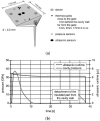Ultrasound Sensors for Process Monitoring in Injection Moulding
- PMID: 34372430
- PMCID: PMC8347947
- DOI: 10.3390/s21155193
Ultrasound Sensors for Process Monitoring in Injection Moulding
Abstract
Injection moulding is an extremely important industrial process, being one of the most commonly-used plastic formation techniques. However, the industry faces many current challenges associated with demands for greater product customisation, higher precision and, most urgently, a shift towards more sustainable materials and processing. Accurate real-time sensing of the material and part properties during processing is key to achieving rapid process optimisation and set-up, reducing down-times, and reducing waste material and energy in the production of defective products. While most commercial processes rely on point measurements of pressure and temperature, ultrasound transducers represent a non-invasive and non-destructive source of rich information on the mould, the cavity and the polymer melt, and its morphology, which affect critical quality parameters such as shrinkage and warpage. In this paper the relationship between polymer properties and the propagation of ultrasonic waves is described and the application of ultrasound measurements in injection moulding is evaluated. The principles and operation of both conventional and high temperature ultrasound transducers (HTUTs) are reviewed together with their impact on improving the efficiency of the injection moulding process. The benefits and challenges associated with the recent development of sol-gel methods for HTUT fabrication are described together with a synopsis of further research and development needed to ensure a greater industrial uptake of ultrasonic sensing in injection moulding.
Keywords: injection moulding; lead-based chemicals; lead-free chemicals; process monitoring; sol-gel; ultrasound sensors.
Conflict of interest statement
The authors declare no conflict of interest.
Figures











References
-
- Kazmer D.O. Injection Mold Design Engineering. Carl Hanser Verlag GmbH & Co. KG; München, Germany: 2007. Injection Mold Design Engineering. - DOI
-
- Rosato D.V., Rosato M.G. Injection Molding Handbook. Springer; Boston, MA, USA: 2000. Chapter 3. - DOI
-
- Pacher G.A., Berger G.R., Friesenbichler W., Gruber D.P., Macher J. In-mold sensor concept to calculate process-specific rheological properties. AIP Conf. Proc. 2014;1593:179–182. doi: 10.1063/1.4873759. - DOI
-
- Ono Y., Whiteside B.R., Brown E.C., Kobayashi M., Cheng C.C., Jen C.K., Coates P.D. Real-time process monitoring of micromoulding using integrated ultrasonic sensors. Trans. Inst. Meas. Control. 2007;29:383–401. doi: 10.1177/0142331207080153. - DOI
-
- Edwards R., Thomas C. On-line measurement of polymer orientation using ultrasonic technology. Polym. Eng. Sci. 2001;41:1644–1653. doi: 10.1002/pen.10862. - DOI
Publication types
MeSH terms
Substances
Grants and funding
LinkOut - more resources
Full Text Sources

